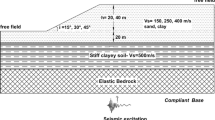Abstract
The present work aims at developing a new neural network–based prediction model for Newmark’s sliding block displacements. The model is developed to predict slope displacement for given earthquake magnitude, focal mechanism, rupture distance, average shear wave velocity of the top 30 m of soil, and critical acceleration of the slope. The network architecture constitutes three layers (only one hidden layer) with nodes per layer 5-5-1. Thus, the network comprises of 36 unknown coefficients. The prediction model utilizes a total of 13,707 data points. Furthermore, inter- and intra-event residuals are evaluated using a mixed-effects algorithm and found to be unbiased, having respective standard deviation accounting to 0.837 and 1.645. The developed slope displacement prediction model is observed to capture the known displacement features, and the patterns are in agreement with the available relations in literature. The applicability of the new model in the estimation of slope displacements hazard is also demonstrated for a representative site in the Himalayan region.










Similar content being viewed by others

References
Abrahamson NA, Silva WJ, Kamai R (2014) Summary of the ask14 ground motion relation for active crustal regions. Earthq Spectra 30(3):1025–1055
Abrahamson NA, Youngs R (1992) A stable algorithm for regression analyses using the random effects model. B Seismol Soc Am 82(1):505–510
Ambraseys N, Menu J (1988) Earthquake-induced ground displacements. Earthquake Engineering & Structural Dynamics 16(7):985–1006
Berry M, Linoff G (1997) Data mining techniques: for marketing, sales and marketing support
Boore DM, Stewart JP, Seyhan E, Atkinson GM (2014) NGA-West2 equations for predicting PGA, PGV, and 5% damped PSA for shallow crustal earthquakes. Earthq Spectra 30(3):1057–1085
Bray JD, Augello AJ, Leonards GA, Repetto PC, Byrne RJ (1995) Seismic stability procedures for solid-waste landfills. Journal of Geotechnical Engineering 121(2):139–151
Bray JD, Travasarou T (2007) Simplified procedure for estimating earthquake-induced deviatoric slope displacements. Journal of Geotechnical and Geoenvironmental Engineering 133(4):381–392
Campbell KW, Bozorgnia Y (2014) NGA-West2 ground motion model for the average horizontal components of PGA, PGV, and 5% damped linear acceleration response spectra. Earthq Spectra 30(3):1087–1115
Chiou BS-J, Youngs RR (2014) Update of the Chiou and Youngs NGA model for the average horizontal component of peak ground motion and response spectra. Earthq Spectra 30(3):1117–1153
Cornell CA (1968) Engineering seismic risk analysis. Bulletin of the Seismological Society of America 58(5):1583–1606
Derras B, Bard PY, Cotton F (2014) Towards fully data driven ground-motion prediction models for Europe. Bull Earthq Eng 12(1):495–516
Dhanya J, Raghukanth STG (2018) Ground motion prediction model using artificial neural network. Pure Appl Geophys 175(3):1035–1064
Dhanya J, Raghukanth STG (2020) Neural network-based hybrid ground motion prediction equations for western Himalayas and north-eastern India. Acta Geophysica 68(2):303–324
Douglas J (2016) Ground motion prediction equations 1964–2016, report. Accessible on http://www.gmpe.org.uk/gmpereport2014.pdf
Du W, Wang G (2014) Fully probabilistic seismic displacement analysis of spatially distributed slopes using spatially correlated vector intensity measures. Earthquake Engineering & Structural Dynamics 43 (5):661–679
Du W, Wang G (2016) A one-step Newmark displacement model for probabilistic seismic slope displacement hazard analysis. Engineering Geology 205:12–23
Foulser-Piggott R, Stafford PJ (2012) A predictive model for Arias intensity at multiple sites and consideration of spatial correlations. Earthquake Engineering & Structural Dynamics 41(3):431–451
Garson GD (1991) Interpreting neural-network connection weights. AI Expert 6(4):46–51
Hsieh S-Y, Lee C-T (2011) Empirical estimation of the Newmark displacement from the Arias intensity and critical acceleration. Eng Geol 122(1-2):34–42
Jibson RW (2007) Regression models for estimating coseismic landslide displacement. Engineering Geology 91(2-4):209–218
Kiureghian AD, Ang AH (1977) A fault-rupture model for seismic risk analysis. Bull Seismol Soc Am 67(4):1173–1194
Møller MF (1990) A scaled conjugate gradient algorithm for fast supervised learning, Aarhus University, Computer Science Department
Muthuganeisan P, Raghukanth STG (2016b) Site-specific probabilistic seismic hazard map of Himachal Pradesh, India. Part II. Hazard estimation. Acta Geophysica 64(4):853–884
NDMA (2011) Development of probabilistic seismic hazard map of India tech. report of the working committee of experts (wce). National Disaster Management Authority (ndma), Govt. of India, New Delhi
Newmark NM (1965) Effects of earthquakes on dams and embankments. Geotechnique 15 (2):139–160
Rathje EM, Saygili G (2011) Estimating fully probabilistic seismic sliding displacements of slopes from a pseudoprobabilistic approach. Journal of Geotechnical and Geoenvironmental Engineering 137(3):208–217
Saygili G, Rathje EM (2008) Empirical predictive models for earthquake-induced sliding displacements of slopes. J Geotech Geoenviron 134(6):790–803
Travasarou T, Bray JD, Abrahamson NA (2003) Empirical attenuation relationship for Arias intensity. Earthquake Engineering & Structural Dynamics 32(7):1133–1155
Author information
Authors and Affiliations
Corresponding author
Additional information
Publisher’s Note
Springer Nature remains neutral with regard to jurisdictional claims in published maps and institutional affiliations.
Electronic supplementary material
Below is the link to the electronic supplementary material.
Rights and permissions
About this article
Cite this article
Gade, M., Nayek, P.S. & Dhanya, J. A new neural network–based prediction model for Newmark’s sliding displacements. Bull Eng Geol Environ 80, 385–397 (2021). https://doi.org/10.1007/s10064-020-01923-7
Received:
Accepted:
Published:
Issue Date:
DOI: https://doi.org/10.1007/s10064-020-01923-7



